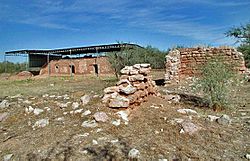Mission San Cayetano de Calabazas facts for kids

Ruins of the mission compound and church at Mission San Cayetano de Calabazas.
|
|
| Location | near Nogales, Arizona |
|---|---|
| Name as founded | La Misión de San Cayetano de Calabazas |
| English translation | The Mission of Saint Cajetan of the Gourds |
| Patron | Saint Cajetan |
| Founding date | 1756 |
| Founding priest(s) | Father Francisco Xavier Pauer |
| Built | 1756 |
| Native tribe(s) Spanish name(s) |
Pima |
| Governing body | Private |
| Current use | Historical Monument |
| Designated | June 3, 1971 |
| Reference no. | 71000118 |
| Designated | December 14, 1990 |
Mission San Cayetano de Calabazas, also known as Calabasas, was a Spanish mission in the Sonoran Desert. Today, its ruins are near Tumacácori, Arizona. The mission was named after Saint Cajetan, an Italian saint.
Contents
History of the Mission
The 1700s: Early Days and Challenges
The first San Cayetano mission was started by Father Eusebio Kino in 1691. This was during his first big trip into the Pimeria Alta region. In 1751, the original mission was destroyed during the O'odham rebellion.
A new San Cayetano mission was then founded in 1756. It was built south of the old site, along the Santa Cruz River. Spanish Jesuit missionary Father Francisco Xavier Pauer started this new mission. He moved at least 78 O'odham from their village to the new location.
By 1761, reports said the mission had a house with a lock. A church was also half-built. In 1772, a church report noted 64 people lived there. It said the land was good for farming. However, the Native Americans did not farm much. There was no church or house for the missionary at that time. But by 1773, the church was working. In 1775, Father Pedro Font held a mass there. This was during the first Juan Bautista de Anza trip to Las Californias.
In 1777, the mission faced a big attack. Apache, some O’odham who had left their faith, and Seris people raided it. They burned the church, houses, and a granary full of corn. The mission's O'odham people killed 14 raiders. But they lost 7 of their own. The mission was left empty in 1786. The last O'odham people left because of constant attacks by the Apaches.
The 1800s: Changes and Abandonment
Between 1807 and 1830, the mission area was used as a farm. It helped support the nearby Mission San José de Tumacácori. In 1808, Spanish settlers and Christian Native Americans moved back to Calabazas. They fixed up the chapel. But in 1830, the Apaches attacked again. They burned the buildings. They also took sacred items from the church. This made people afraid to live there for over 20 years. However, vaqueros (cowboys) from Tumacácori still grazed cattle nearby.
In 1837, the Mexican government built Presidio de Calabasas. This fort was meant to protect the area. In 1844, Mission Calabasas and its lands were sold. The buyer was the brother-in-law of Sonora governor Manuel María Gándara. Gándara started a ranch at the old mission. He had 6,000 cattle there.
In 1854, the Gadsden Purchase happened. The U.S. bought this land from Mexico. It became part of the New Mexico Territory. Mexican soldiers, who were protecting citizens from Apaches, left the area in 1856. With their departure, the Gándara ranch ended.
Later in 1856, the mission church became a temporary home. Major Enoch Steen lived there. He was a commander of U.S. soldiers. They set up Camp Moore at the former Presidio de Calabasas. This was the first military post in the Gadsden Purchase area. The new governor of Sonora, Ignacio Pesqueira, allowed supplies to cross the border. With military protection, American settlers moved into the area. The next year, Steen moved his camp. It was moved 25 miles northeast to Sonoita Creek. The new post was named Fort Buchanan. It honored President James Buchanan.
After this, the old mission buildings were used for different things. In 1857, it was a customs house. The family of Larcena Pennington Page lived in the ranch house before September 1859.
In September 1865, the Union Army moved its soldiers to Old Camp Moore at Calabasas. It was first called Post at Calabasas. Then it was named Fort Mason. This honored General Mason. He was a commander of the California Volunteers. Soldiers stayed there until May 1866. But many soldiers got malaria. So, the army left the fort in October 1866. They set up Camp Cameron instead.
By 1878, Mission Calabazas was completely in ruins. Only a shell of the building remained, with no roof.
Protecting the Mission
In 1960, Father Norman Whalen helped protect the mission. Volunteers capped the adobe walls. They also put in a concrete foundation. The Arizona Historical Society took over the site in 1974. The Mission became part of Tumacácori National Historical Park in 1990.
It was named a National Historic Landmark in 1990. It is also on the National Register of Historic Places.
See also
 In Spanish: Misión de San Cayetano de Calabazas para niños
In Spanish: Misión de San Cayetano de Calabazas para niños

